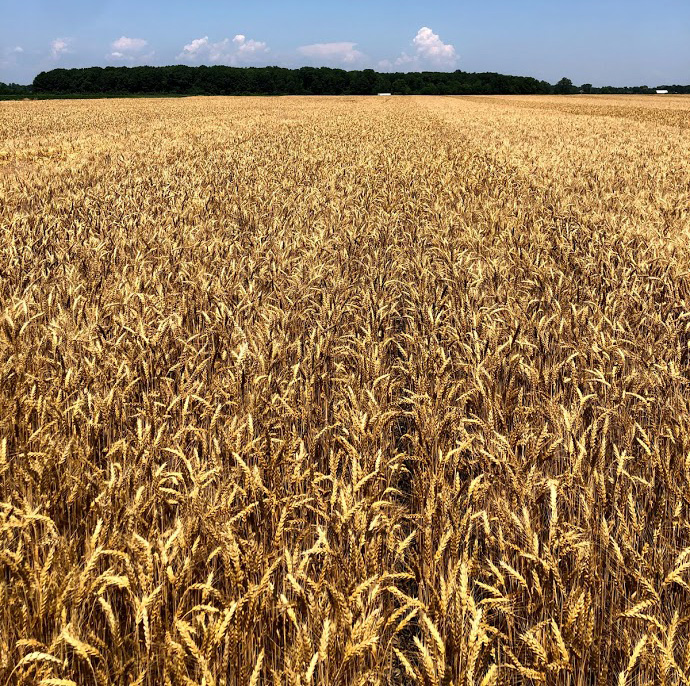Cover crops are on deck as wheat and other small grains are being harvested
Cover crops after wheat can help to protect your soil and minimize pest pressure for the upcoming crop.

As the harvest of wheat and other small grain crops are occurring in parts of Michigan, it is time to consider options for planting cover crops. Allowing a cover crop to take advantage of the remaining two to three months of favorable weather conditions can protect the soil from erosion by wind and water, scavenge nutrients for future cash crops, and feed the organisms in the soil food web. Cover crops also help prevent summer annual weeds from producing seed and winter annuals weeds from emerging, and possibly provide an opportunity for grazing.
Selecting a cover crop for your operation comes down to assessing your goals and desired management strategies, and considering if the herbicide applications made to the wheat crop may limit your options.
What are your cover cropping goals?
A goal such as weed suppression requires a cover crop that will emerge quickly and cover the soil surface to increase competition for light, water and nutrients, and reduce further emergence. Quick emerging cover crops include oilseed radish, oats, sorghum-sudangrass and cereal rye. If adding nitrogen to the system is your goal, then planting a legume would be your best option. Legume choices include medium red clover, crimson clover, field pea, sweet clover and hairy vetch.

The Michigan State University Extension tip sheet, “Cover Crop Choices Following Winter Wheat,” details specific options and planting recommendations, and can be found on the MSU Cover Crops website. Another resource to assess which cover crops will meet your goals is the Cover Crop Selector Tools from the Midwest Cover Crop Council. This interactive tool incorporates local climate information, soil characteristics and personal goals to help tailor your cover crop search. It also provides printable information sheets for species of interest.
If you are new at integrating cover crops into your rotation, the MSU Extension cover crop team has come up with a “recipe” for you: “Michigan Cover Crop Recipe – Post Wheat, Going to Soybean or Corn: Use Oats and Radish Mix.”
How will you plant the cover crop?
Often, cover crops can be planted using a drill, planter or broadcast seeder. Larger seeded species, such as rye, pea and sorghum-sudangrass, benefit from being placed in the soil profile, and therefore a drill or planter are the best choices. If broadcast seeding is used, light incorporation is recommended to improve seed to soil contact.
How will you terminate the cover crop?
If you are looking for a cover crop that does not require termination, species or combinations of species such as radish, turnips, mustards, oats and sorghum-sudangrass may be good choices as they will not survive a typical Michigan winter. Cover crops that are likely to survive winter include red clover, crimson clover, winter pea, hairy vetch, cereal rye, winter wheat, winter triticale, winter barley, annual ryegrass and Dwarf Essex rapeseed.
All of these cover crops will require termination via tillage or herbicides in spring. Certain cover crops, such as annual ryegrass, with its extensive root system, can require multiple termination efforts and may be more suited to an experienced cover crop user.
Are there any limitations based on your herbicide applications to the small grain?
Depending on the species, cover crops are sometimes, but not often, listed in the crop rotation intervals on the herbicide labels. You can find recommendations on how fall and spring herbicide applications in wheat will impact frost-seeded red clover in the 2020 MSU Weed Control Guide for Field Crops (E0434). These recommendations could be used to conservatively assess any risks to seeding red clover following wheat.
For other species, there are recommendations from North Dakota State University that were released in 2017. Their research shows the herbicide Widematch (applied in spring, clopyralid and fluroxypyr- Group 4 synthetic auxins) had the greatest potential for injury (cover crops planted two to 2.5 months after herbicide application), with radish, turnip and rapeseed being 21-50% damaged and field pea and lentil being 51-100% damaged. Spring applications of Clarity (dicamba- Group 4) also showed injury potential on radish, lentil, flax and barley at 21-50% injury, and turnip at 51-100% injury. The full chart listing the risk of injury can be found in the North Dakota State University article, “How do wheat herbicides affect fall cover crops?”
For more information regarding cover crops, contact your local MSU cover crops expert.



 Print
Print Email
Email